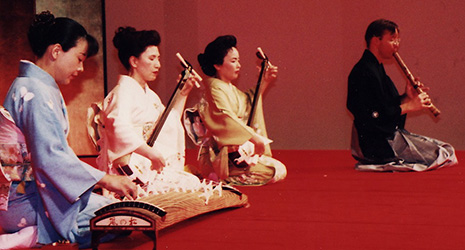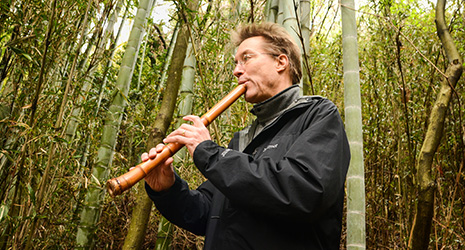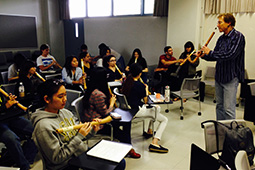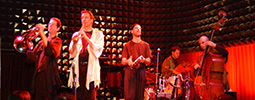August 2022
The Comforting Timbre of the Shakuhachi

Huebner performs the classical piece “Shiki no Nagame” (View of Four Seasons) in a traditional setting with shamisen and koto 
Bruce Huebner

Huebner lectures on shakuhachi at Meiji Gakuin University in Yokohama 
Huebner (second from left) performs with the Candela ensemble at Joe’s Pub in New York City

American Bruce Huebner is a shakuhachi player who performs across borders and musical genres.

The shakuhachi is a traditional Japanese end-blown flute made from bamboo. Breath is exhaled into an embouchure hole at the top of the instrument, and there are four finger holes on the front and one on the back. The sound is changed by a combination of placing or lifting the fingers over the holes and the lip angles over the embouchure hole.
“There are aluminum shakuhachi nowadays, but in the end I prefer bamboo,” says Bruce Huebner. “There is a warmth to the timbre that fits well with nature. When playing outdoors, it sounds as if the music is melting into nature.”
Bruce is from California, and he has been pouring his passion into the shakuhachi for over thirty years. Based in Japan, he has performed both as a soloist and together with musicians from a variety of genres in many countries around the world.
Both of his parents are music lovers, and Bruce began studying the flute from age 10 and saxophone from age 14; he was especially enthusiastic about the musical genre of jazz. He first heard the sound of a shakuhachi when studying music at California State University, Northridge. By chance, he heard a performance on the radio of shakuhachi player Yamaguchi Goro (1933–1999), a holder of Important Intangible Cultural Property (commonly referred to as a Living National Treasure) and Bruce’s future teacher. Bruce was spellbound by the timbre of the shakuhachi, which was different from that of the Western music he had been familiar with since childhood. Later, he was lucky enough to hear a live performance of three Japanese traditional instruments (shakuhachi, shamisen, and koto*) at a Los Angeles art museum, and he became even more interested in the shakuhachi and Japan. In 1983, after graduating from university, he moved to Japan and began studying the shakuhachi while attending Japanese language school.
Looking back, he says, “The shakuhachi is at first glance an instrument with a simple construction, so it looks easy to play. But I learned as soon as I picked it up that it is extremely difficult to actually produce a sound. To tell the truth I couldn’t produce a sound at all. My experiences with flute and sax were mostly useless.”
A delicate technique is necessary to produce a rich sound with the shakuhachi. The timbre changes slightly based on the strength of breath, the way the finger holes are covered, the angle of the head, the movement of the throat and chin, and more. A player can produce all sorts of tones by combining these elements.
“In spite of an apparent lack of technology like keys, finger holes, embouchure plate or metal construction, the shakuhachi has tremendous potential as a tool for music making. Ironically the unique simple construction allows the player tremendous freedom to create sounds and express emotion.”
After about three years in Japan, Bruce went back to America and earned a Master’s degree in Asian Studies from the graduate school at the University of California, Santa Barbara. Then in 1990, he came back to Japan as an international student sponsored by the Ministry of Education (now the Ministry of Education, Culture, Sports, Science and Technology), and entered the Master’s program at the Department of Traditional Japanese Music in the Music Faculty of Tokyo University of the Arts. He was the first non-Japanese student to enter the Traditional Japanese Music Master’s program at that university. There he studied under Yamaguchi Goro and completed his degree program at the top of his class in 1994.
After that, he began to perform as a professional shakuhachi player in Japan. Alongside giving traditional shakuhachi performances, he also collaborated with musicians from a variety of genres to expand the potential of the shakuhachi. In 2000, he formed Candela, a five-person ensemble, together with American jazz pianist Jonathan Katz, performing not just in Japan, but at the Toronto Jazz Festival in Canada, Blue Note in New York, and more.

Candela received high praise from an American critic who said that the group “successfully incorporates the shakuhachi and combines the best of Latin, European and Japanese traditions.”
He later formed Curt & Bruce in 2008 with American koto player Curtis Patterson, presenting Japanese traditional music as well as jazz, improvisation, original music, and more in concerts in Japan and around the world.
Bruce actively performs at shrines, restaurants, parks, and places without traditional connections to shakuhachi so that even more Japanese people can come to know the beauty of the instrument. He says that he is delighted when Japanese people from the audience tell him that they have rediscovered the shakuhachi after hearing him play.

Since the Great East Japan Earthquake in March 2011, he frequently visits the affected areas in the Tohoku region and has performed extensively at evacuation shelters, temporary housing, and other locations. Among the affected areas, Fukushima Prefecture is a beloved place to Bruce, and one which he calls his “second home,” as he lived there for about six years before the earthquake. He says that when performing local folk songs, he can hear singing voices, handclaps, and sobbing from the audience.
“The sound of the shakuhachi is medicine for the soul. It soothes the soul,” he says. “I want to keep on performing this kind of music.”
* For the shamisen, see “Cultural Envoys,” Highlighting Japan, November 2021 issue: https://www.gov-online.go.jp/eng/publicity/book/hlj/html/202111/202111_12_en.html. The koto (or so) is an instrument with 13 strings (usually) strung over a long wooden body with moveable bridges.

